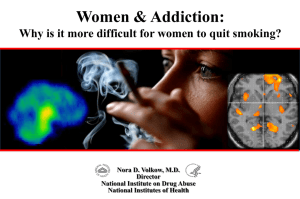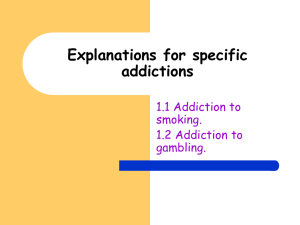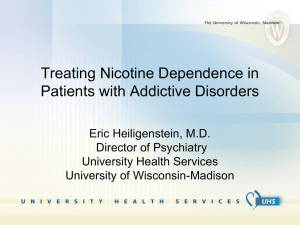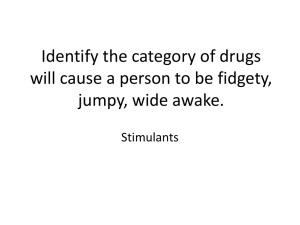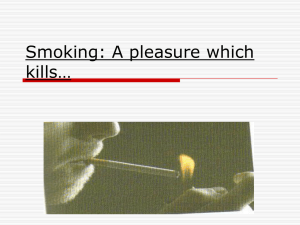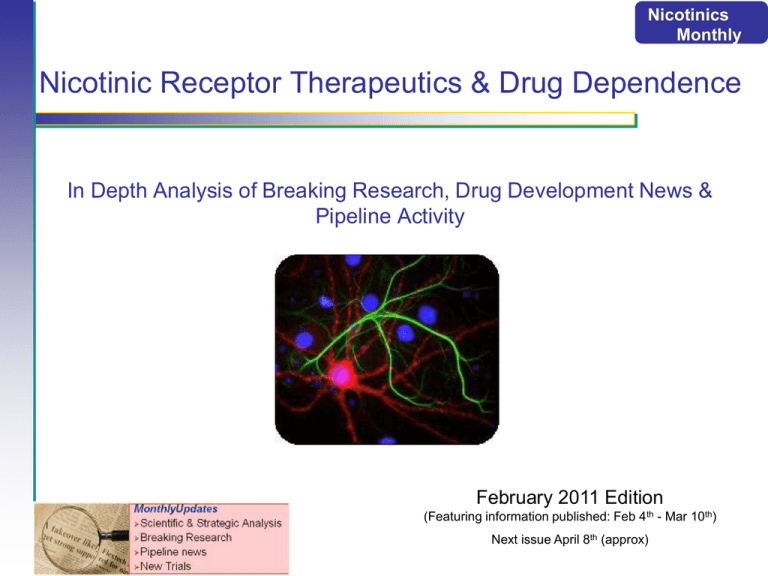
Nicotinics
Monthly
Nicotinic Receptor Therapeutics & Drug Dependence
In Depth Analysis of Breaking Research, Drug Development News &
Pipeline Activity
February 2011 Edition
(Featuring information published: Feb 4th - Mar 10th)
Next issue April 8th (approx)
UpdatesPlus: Subscription Information
Nicotinics
Monthly
•
To subscribe to receive future editions of UpdatesPlus-Nicotinic
Receptors: please fill in this page and fax back to us on +44 (0)870 7525685 or
contact us for further details
•
Annual subscription cost £7000. Subscription allows company wide distribution
of 12 monthly editions.
• Card#................................
• Expiry……………………...
• 3 digit security #................
•
For UpdatesPlus in your area: This file is intended to represent an example of
the type of service provided by LeadDiscovery’s UpdatesPlus service
•
If you are interested in receiving UpdatesPlus in your therapeutic area please
contact us (leaddisc@leaddiscovery.co.uk or +44 (0)1580831877)
Executive summary of new activity
Nicotinics
Monthly
February 2011 - Key activity around the α7 receptor
•
•
•
•
TC-5619 - Phase 1 Alzheimer’s study now fully enrolled: Targacept has been
evaluating TC-5619 in Phase 2a studies of ADHD and CIAS. Positive top line CIAS
data were reported in the December issue of UpdatesPlus; ADHD data are expected
very shortly. In February Targacept announced through clinicaltrials.gov that a Phase 1
Alzheimer’s disease study is also now fully enrolled and that data remains on track to
read out in Q2 2011.
PAM assay from Abbott: Abbott has displayed an interest in PAMs. A recent Abbott
patent claims screening tools for the identification of α7 PAMs (WO 2009/003074).
Company researchers have now published one assay in detail. In particular the assay
is compatible with HTS for Type II PAMs (ie those that increase peak response and slow
desensitization).
α7 receptor agonists as potential treatments of thrombocytopenia: Chronic
immune thrombocytopenic purpura (ITP) and drug induced thrombocytopenia require
new treatment approaches. The potential market for new treatments may exceed $0.5
billion. New research has shown α7 antagonism blocks platelet differentiation;
extending this finding by demonstrating agonist-induced differentiation would support
further expansion of the nicotinics field into the treatment of platelet diseases.
Can α7 receptor agonists improve mortality and morbidity after cardiac arrest?
Delayed mortality and morbidity after cardiac arrest is due in part to global cerebral
ischemia. New research suggests that α7 agonists can limit cerebral inflammation and
hippocampal cell damage.
Executive summary of new activity
Nicotinics
Monthly
February 2011 - Key activity around the α4β2 receptor
•
•
New Phase 1 study of TC-5214 announced: We have learned that Quintiles is looking
for 32 patients to include in a Phase 1 study of TC-5214. The study will assess the
safety, tolerability and pharmacokinetics of the candidate in elderly patients. We believe
that this study simply reflects filling requirement, allowing data to be included on an
eventual product label on special populations. Data in the elderly would however be
useful given the prevalence of depression in this cohort.
GSK/Targacept alliance terminated as GSK realigns CNS activities: Targacept and
GSK have been collaborating since 2007 in various CNS diseases. GSK has now
terminated its alliance with Targacept due to GSK’s strategic changes in the
neurosciences area in 2010. This is not expected to present a major problem to
Targacept given its evolution as a company over recent years. Companies interested in
in-licensing candidates emerging from the collaboration may stand to benefit;
alternatively Targacept should hopefully be in a position to advance these candidates
unilaterally if necessary.
Executive summary of new activity
Nicotinics
Monthly
February 2011 - Key activity around other nicotinic receptors
•
Researchers identify bupropion analogues with α3β4* affinity and smoking
cessation potential: Researchers at the Research Triangle Institute have identified
analogues of the smoking cessation product, bupropion. These analogues have been
suggested to act through the modification of dopamine and norepinephrine uptake as
well as stimulation of α3β4* receptor activity.
Executive summary of new activity
Nicotinics
Monthly
January 2011 - Key activity around smoking cessation
•
•
•
•
Varenicline study opens in paediatric patients: Smoking remains a serious problem
in adolescents. In an attempt to help address this problem Pfizer has opened a study of
300 adolescents smokers. The primary end-point will read out in Aug 2013. This study
has the additional advantage for Pfizer in that it could result in a paediatric extension.
Johnson & Johnson opens new nicotine replacement therapy study: The product
being evaluated in the study (NCT01296698) is not disclosed. Of note the 1500 subject
study is apparently a pharmacy based one. This design has been selected to make the
study more naturalistic. Initial screening and data collection will be conducted by the
pharmacist.
NicVax extension study opens: Nabi, in partnership with GSK, is currently conducting
two Phase 3 registration trials of NicVax. This vaccine generates antibodies to nicotine
which are hoped to prevent temporary lapses developing into full relapse by neutralizing
nicotine. Both studies are now fully enrolled and should read out Q1 2012. An extension
study (NCT01304810) has now been advanced. This is simply an observational study
and will monitor antibody persistence.
Duke University evaluates new smoking cessation strategy: Individuals who appear
unlikely to abstain on nicotine replacement therapy alone will be randomized to receive
varenicline alone or combined with bupropion. The remarkably large study
(NCT01303861) is recruiting 1500 people and is due to read out H2 2012.
Executive summary of new activity
Nicotinics
Monthly
January 2011 - Key activity around drug dependence (excluding nicotine)
•
•
•
Omeros expands its drug addiction portfolio by in-licensing PDE7 inhibitors from
Daiichi: Omeros has an addiction program, initially focused on the development of
PPARγ agonists. Last year Omeros received an exclusive licence to develop Daiichi's
PDE7 inhibitors as treatments for movement disorders, such as Parkinson's disease.
Now Omeros has now announced that it is investigating these inhibitors for the
treatment of addiction.
NK1 antagonists for the potential prevention of relapse in recovering alcoholics:
Relapse is a common event in recovering alcoholics. This can be induced by alcohol
cues or stressful life events. NK1 antagonists have been developed for anxiety and
depression. Data has now shown that this class may be of use in preventing stress
induced relapse in alcoholics.
Muscarinic M4 receptor agonists as candidates for cocaine addiction? Genetic
deletion of the M4 receptor has been shown to increase cocaine self-administration.
This suggests that the development of agonists as candidate treatments of addiction is
warranted.
This Month’s activity around the α7
receptor
Nicotinics
Monthly
Nicotinics
Monthly
Pipeline Overview – α7 ligands
Preclin
Phase 1
Xytis – XY 4083
Targacept – TC-6987
Neuroderm - ND0801
Asmacure - ASM-024
Novartis - AQW051
Targacept - TC-5619
EnVivo - EVP-6124
Roche - RG3487 (RO-5313534)
Phase 2
Phase 3
Alzheimer’s - Xytis no longer trading?
Ph 2 Opened: Q1 2011
Ph 2 Opened: Q2 2010
Ph 2 Opened: Q2 2010
Ph 2 opened 2010
Ph 2a Completion Q1 2011 (CIAS; ADHD)
Ph 2b Completion: Q1 2011 (AD)
Ph 2b Completion: Q3/Q1 2011 (AD/CIAS)
Asthma/Diabetes
ADHD
Asthma
CIAS
CIAS/ADHD/Alzheimer’s(?)
Alzheimer’s/CIAS
Alzheimer’s
Positive Allosteric Modulators
Agonists
Pipeline Overview – α7 ligands
Pipeline changes for February 2011
•No Changes
Nicotinics
Monthly
Targacept discloses a few further details on
Phase 2 TC-6987 studies
•
•
The January issue of UpdatesPlus featured the initiation of Targacept’s Phase 2 studies
of TC-6987 in asthma and diabetes.
The asthma study has now been posted on clinicaltrials.gov (NCT01296087).
–
–
–
–
•
Nicotinics
Monthly
As previously reported, mild to moderate asthmatics are being enrolled into this US randomized placebo
controlled trial.
During an initial 4 week run-in period, patients will receive low-dose inhaled corticosteroid and cease taking
their current asthma medication.
On top of this baseline, patients will receive TC-6987 at 100mg for the first day of dosing followed by 50mg for a
further 4 weeks. Placebo will be dosed in a control arm. As is standard for asthma studies, improved FEV will
be the primary end point.
We now know that TC-6987 will be dosed orally contrasting with ASM-024, an inhaled nicotinic agent in
development for asthma. In addition, individuals using strong P450 3A4 (CYP3A4) inhibitors are being
excluded suggesting this enzyme is responsible for the metabolism of TC-6987.
The diabetes study has also been posted (NCT01293669).
–
–
–
On the entry TC-6987 is described as an open channel stabilizer. In vivo data were also disclosed and
particularly that TC-6987 improved both metabolic parameters (plasma glucose, triglyceride, and Hb1Ac) and
reduced inflammatory mediators (TNF-α).
Patients will receive TC-6987 or placebo as a monotherapy after a 4 week wash-out. Dosing will be with 20mg
for the first day dropping to 10mg for the remainder of the dosing period (note that the dose is considerably
lower than for the asthma study).
Fasting plasma glucose will be the primary measure.
Nicotinics
Monthly
Thrombocytopenia: A group of platelet
diseases potentially treatable by α7 agonists?
•
•
Thrombocytopenia is defined as an abnormally low platelet
level and is associated with clotting disorders.
The common autoimmune disease, immune thrombocytopenic
purpura (ITP) is caused by platelet antibodies. ITP presents as:
–
–
•
•
•
•
•
Acute self-limiting ITP which is primarily a paediatric condition.
Chronic ITP, an orphan disease affecting 3-5/100,000 adults.
Thrombocytopenia can also arise as a side effect of cytotoxic
agents and ribavirin (used in HCV treatment)
Treatment of thrombocytopenia has changed in the past
decade with the current focus on two new thrombopoietin
mimetics (TPO): romiplostim (Nplate; an injectable peptide) and
eltrombopag (Promacta; an orally small molecule).
Romiplostim is disadvantaged by its peptidic nature while
eltrombopag carries a black box warning of hepatotoxicity.
Rodman & Renshaw has forecast sales of $510 million by 2012
for Promacta assuming approval for oncology and HCV. So far
sales remain at $50 million with indications limited to ITP.
With Promacta having failed to live up to expectations there is
potentially space for new platelet stimulation agents and recent
data suggests nicotinic agents could fill this niche.
Few pipeline candidates target
thrombocytopenia
Veltuzumab
(Immunomedics)
S-888711
(Shionogi)
No Phase 3
candidates
2285921
(GSK)
Phase 2
Phase 3
Platelets as a new target for α7 nicotinic
agonists?
•
•
•
•
•
In addition to thrombopoietin receptors,
components of the cholinergic system have
been
detected
in
platelet
precursors
(megakaryocytes), and platelets themselves.
Moreover cholinergic agonists have been shown
to modulate megakaryopoiesis and stimulate
megakaryocyte proliferation.
In 2010 Schedel et al reported the expression of
α7 receptors on platelets.
The same group has now reported that MLA,
used at concentrations known to antagonize α7,
blocks megakaryocyte differentiation (Thornton
et al. 2011; see inset).
This suggests that α7 agonists may enhance
differentiation offering a new approach to the
treatment of thrombocytopenia.
The next obvious study would be to determine whether
an α7 agonist is able to stimulate platelet generation
and to compare this to the effect of a TPO.
Nicotinics
Monthly
Megakaryoblasts were stimulated by the differentiation
factor, TPA. This caused increased expression of the
megakaryocyte marker, CD61. This was reduced by
both nicotine and MLA
New data suggests α7 agonists may limit
post resuscitation cerebral ischemic damage
•
•
•
•
•
•
In the US, according to the AHA, emergency medical
personnel treat ≈300,000 victims of out-of-hospital
cardiac arrest each year.
Sasson et al, 2009 reported that 24% of those treated
survived to hospital admission.
However, <8% of victims survived to discharge. Delayed
mortality and morbidity is due in part to global cerebral
ischemia following successful resuscitation.
Using a rodent model, Norman et al have now reported
the involvement of α7 receptors in cerebral ischemia.
The authors report that cardiac arrest/cardiopulmonary
resuscitation
(CA/CPR)
increased
hippocampal
proinflammatory mediators. Elements of the cholinergic
system were also down-regulated.
Treatment with GTS-21 reversed the elevation in
hippocampal IL-6 and microglial number (top panel)
suggesting anti-inflammatory activity. This was reflected
in reduced hippocampal neural cell damage (lower
panel).
Each of these changes was inhibited by
mecamylamine
Nicotinics
Monthly
Effect of GTS-21 on hippocampal inflammation
and neural death following CA/CPR
Microglia marker, MAC1 was reduced in
rodents subject to CA/CPR and treated with
GTS-21 daily post arrest
Fluro-Jade levels were also reduced by GTS21 reflecting reduced neural damage
This Month’s activity around the α4ß2
receptor
Nicotinics
Monthly
Nicotinics
Monthly
Pipeline Overview – α4ß2 ligands
Preclin
Phase 1
Phase 2
Abbott- A-969933/NS9283
Targacept/GSK - TC-5653 (dual α4ß2/α6)
Targacept - AZD3480 Backups
Amgen - Unnamed cpds
Suven - SUVN-911
Suven - SUVN-F90101; SUVN-F90201
Antagonists
Partial Agonists
PAM
Smoking Cessation (patch)
Cognition
IBS
Pfizer – Varenicline (LCM)
Abbott/NeuroSearch – ABT-560
Targacept – TC6499
Pfizer - CP-601927
Targacept/AstraZeneca (AZD1446/TC-6683
AstraZeneca – ispronicline (AZD3480/TC-1734)
Abbott/NeuroSearch - ABT-894 (Sofinicline)
Abbott - ABT-089 (Pozanicline)
CoMentis – ATG-3 (Mecamylamine)*
AGI - AG-004 (Mecamylamine)*
Pfizer – Varenicline
Phase 3
Ph 2a
Ph 2b ? Starting in Q1 2011
Ph 2b Completed 2008
Ph 2b Completed 2008 - presumed terminated
Targacept - TC-5214
*Mecamylamine is considered a poorly selective nicotinic ligand
Depression
Alzheimer’s
ADHD
ADHD
ADHD/Alzheimer’s
AMD
Alzheimer’s
Diarrhea
Ph 2 (mono) & Phase 3 (add on) Started Mid-2010
Depression
• NDA H2 2012
• MAA 2015
Pipeline Overview - α4ß2 ligands
Pipeline changes for February 2011
• No changes
Nicotinics
Monthly
Phase 1 study of TC-5214 about to start in
the elderly
•
•
•
The Phase 3 program, RENAISSANCE, studying TC-5614 as a
candidate treatment for depression is now well underway.
We have recently learned that the CRO, Quintiles is looking for 32
patients to enrol into a Phase 1 study of TC-5214.
The trial, which will take place at a single site in Sweden, is expected to
be completed by April this year and will assess the safety, tolerability
and pharmacokinetics of multiple oral doses of TC-5214 in medically
stable patients, more than 65 years old.
This study probably reflects a filing requirement, evaluating the safety of TC-5214
in special populations including the elderly. It should be noted however that
depression is an especial problem in the elderly. The generation of efficacy data
subsequent to this study could help promote the sale of TC-5214 post-launch.
Nicotinics
Monthly
Nicotinics
Monthly
Targacept and GSK go their separate ways
as GSK realigns its activity within the neurosciences
•
•
•
•
•
•
Targacept and GSK have been collaborating since 2007 in five therapeutic areas pain, smoking cessation, addiction, obesity and Parkinson's disease.
The collaboration produced TC6499 for the treatment of pain however this
development was stopped in 2009 due to an insufficient therapeutic margin.
Targacept has since switched indications to IBS.
In addition the companies were developing a dual α4ß2/α6 agent which we believe
was being targeted towards smoking cessation. Activities around this indication have
drawn in milestone payments for Targacept in the past.
GSK has now terminated its alliance with Targacept due to GSK’s strategic changes
in the neurosciences area in 2010.
While this is obviously not ideal for Targacept it has gained full rights to the
programmes and related candidates that were within the alliance. This opens up the
possibility of new partnering opportunities.
Since the alliance was opened Targacept has evolved as a company with market
entry potentially on the horizon. Revenue generated by the launch of molecules such
as TC-5214 means that Targacept should hopefully be in a good position to continue
development of assets emerging from the GSK partnership even if it doesn’t find
another partner to replace GSK.
This Month’s activity around other subtypes
Nicotinics
Monthly
Nicotinics
Monthly
Researchers identify bupropion analogues
with α3β4*affinity and smoking cessation potential
•
•
•
•
•
Researchers at the Research Triangle Institute have been developing analogues of
bupropion for the treatment of nicotine dependence.
These analogues have been suggested to act through the modification of dopamine
and norepinephrine uptake as well as stimulation of cholinergic receptor activity.
Further activity has now been reported around a 2-(substituted phenyl)-3,5,5trimethylmorpholine scaffold.
Analogues from this series were profiled in vitro and then evaluated in two animal
models: nicotine induced antinociception and nicotine-conditioned place preference.
These are assays for the acute and reward effects of nicotine.
Two molecules were selected as being of especial interest as smoking cessation
candidates.
Chemistry
R1
In vitro profile
(IC50 nM)
R2
bupropion
In vivo activity
(AD50 mg/kg)
DA
NE
α3β4*
Tail-flick
CPP
660
1900
1.8
1.2
0.35
5e
CH3
C2H5
44
24
0.79
0.029
0.025
5f
CH3
C3H7
61
13
0.98
0.056
0.03
This Month’s activity around smoking
cessation/nicotine dependence
Pharmacologic approaches
Nicotinics
Monthly
Pipeline Overview
Smoking cessation/nicotine dependence
Preclin
Phase 1
Phase 2 Phase 3 Marketed
Pfizer - Varenicline (LCM)
Acrux - Nicotine MDTS
Aradigm - ARD-1600
Cary Pharmaceuticals - QuitPak
Cytos/Novartis - NIC002
Celtic Pharma -TA-NIC
Independent Pharma - Niccine
Nabi Pharma - NicVax
Pfizer - Chantix/Champix
GSK - Niquitin CQ
GSK - Bupropion
Nicotinics
Monthly
Phase 3 studies to complete 2012
Pipeline Overview – Smoking Cessation
Pipeline changes for February 2011
•No Changes
Nicotinics
Monthly
Pfizer opens US paediatric varenicline study
•
•
•
•
•
•
According to data from 1999-2004 (CDC National
Health Statistics Reports, 2009), 37% of
adolescents who smoked were daily smokers and
33% smoked ≥6 cigarettes per day.
2009 figures (CDC, Health, United States, 2010)
show a remarkable fall in the rate of adolescent
smoking however this trend has flattened out and
there remains a clear need to address smoking
cessation in younger individuals.
With these statistics in mind it is of interest to note
that Pfizer has opened a new varenicline study in
adolescents (NCT01312909).
The US study will enrol 300 adolescents who
smoke at least 6 cigarettes/day.
The study is similar to varenicline registration
studies.
Of note however, a half dose of
varenicline will be used in lighter individuals.
The primary end-point will read out in Aug 2013
Nicotinics
Monthly
Adolescent smoking remains
high in the US
Although success in this study would
be of potential use in reducing the rate
of adolescent smoking, it would also
benefit Pfizer.
Not only could it
increase the size of the market, the
study could also support a paediatric
extension for varenicline.
Study opens to evaluate varenicline for
smoking reduction in those not ready to quit
•
•
•
•
Nicotinics
Monthly
Nicotine replacement therapies were initially approved in order to help immediate
smoking cessation. However in 2005 regulations in some regions changed to allow the
use of such therapies as a stepping stone to quitting.
A 2007 systematic review suggested that a substantial reduction in smoking improved
several cardiovascular risk factors, and respiratory symptoms (Pisinger & Godtfredsen,
2007).
Consequently, regulatory authorities and particularly those in the UK have allowed the
use of NRT to help reduce or temporarily stop smoking. Indeed a recent survey of
English smokers has revealed that 28% of smokers use nicotine replacement therapy
for this purpose.
Of interest New Jersey researchers have now opened a study (NCT01308736) of 60
individuals to determine whether varenicline can reduce smoking in individuals not
wishing to quit.
This study is of interest given that varenicline has a boxed warning. If the study does demonstrate a
reduction in the number of cigarettes smoked without a significant reduction in abstinences we ask what
the implications may be? The study is too small to bring about change on its own but a larger study
could pressure regulators to approve varenicline as a smoking reduction strategy. We doubt whether
this would occur unless high risk patients were to be studied, ideally with clinical outcomes measures.
Arbi Group and Italian Antismoking League
complete E-cigarette studies
•
•
•
The Arbi Group, an Italian electronic cigarette
retailer, in collaboration with the Italian antismoking league, opened a number of studies in
2010.
The studies (NCT01188239; NCT01194583;
NCT01164072) were investigating the ability of Ecigarettes to reduce smoking.
These studies are no longer recruiting and we
believe that data is now available.
Nicotinics
Monthly
Smokers with no
intention to quit
wk2
Base
Wk4
wk6
wk8
wk10 wk12
Study visit
to monitor
1O Outcome Measures
•Sustained 50% reduction in cigarettes at each visit
•Sustained smoking abstinence at wk12
2O Outcome Measures include
•Sustained 80% reduction in cigarettes at each visit
•Sustained smoking abstinence at wk24
•Withdrawal suppression
•Cravings reduction
•Adverse events
This Month’s activity around drug
dependence (excluding nicotine)
Pharmacologic approaches
Nicotinics
Monthly
Pipeline Overview
Drug dependence (excluding nicotine)
Phase 1
Nicotinics
Monthly
Phase 2
Phase 3
Marketed
NanoBUP (Nanotherapeutics)
AIKO-150 (AIKO)
Omeros (PPARγ ligands)
Lilly (LY-2456302)
GSK (618334)
BioDelivery (buprenorphine/naloxone)
Orexa (Buprenorphine/Naloxone)
Alkermes (ALKS 33)
BioTie (Nepicastat; SYN-117)
Lilly (OprA)
Catalyst (CPP-109)
Lundbeck/BioTie (Nalmefene)
Titan (Probuphine)
Generic Suboxone (buprenorphine/naloxone)
Generic Subutex (buprenorphine)
Alkermes (VIVITROL)
Reckitt Benckiser (Suboxone Film)
Forest/Meram (CAMPRAL/AOTAL)
Pivotal Phase 2b started; IND H2 2012?
MAA Expected H2 2011
Pipeline Overview – Drug dependence
(excluding nicotine)
Pipeline changes for February 2011
•No Changes
Nicotinics
Monthly
D&A Pharma is about to file reformulated
treatments of alcohol and opiate addiction
•
•
•
•
Sodium oxybate has been marketed in Italy for several years
as a liquid-formulation for alcoholism.
This product is
unfortunately also used as a street drug and therefore has
significant misuse potential.
D&A Pharma is addressing this through the development of
SMO-IR, an immediate-release, thin-pellet formulation.
The company expects to file in Europe in 2011 having
demonstrated bioequivalence of SMO-IR with sodium
oxybate. A granule formulation may follow on from SMO-IR
At the same time the company has reported that it also
intends to file an “undisclosed dual µ/κ opioid agonist” for the
treatment of opiate addiction. This product is presumed to be
a reformulation of suboxone.
Nicotinics
Monthly
Omeros expands its drug addiction portfolio
by in-licensing PDE7 inhibitors from Daiichi
•
•
•
•
•
Nicotinics
Monthly
Omeros has an addiction program, initially focused on the development of
PPARγ agonists. Pilot human and preclinical data suggest that this class may
be most effective in the treatment of addiction to opioids, alcohol and nicotine.
Efficacy as a treatment of psychostimulant addiction (cocaine and
methamphetamine) is expected to be less impressive.
Last year Omeros received an exclusive licence to develop Daiichi's PDE7
inhibitors as treatments for movement disorders, such as Parkinson's disease.
Now Omeros has now announced that it is investigating these inhibitors for the
treatment of addiction, thus expanding their activities within the drug
dependence field.
PDE7 appears to modulate the dopaminergic system and according to Omoros,
PDE7 inhibitors have been shown to reduce cocaine self-administration, inhibit
cue and stress induced relapse, and facilitate drug abstinence in models of
cocaine addiction.
Under the amended deal, milestone payments from Omeros to Daiichi have
increased from $23.5 million to $30.2 million.
NK1 antagonism reduces stress-induced
reinstatement of alcohol intake
•
•
•
•
•
NK1 antagonism has previously been shown to prevent the
rewarding effect of morphine. Schank et al now report the
effect of this therapeutic class on alcohol consumption.
Previous studies have implicated the potential efficacy of NK1
antagonists in treating alcoholism however it is not clear if
such agents would suppress ongoing excessive alcohol use,
prevent relapse, or both.
In their paper published in Psychopharmacology, the NIH
group reports that LY822429 fails to modify alcohol selfadministration in rodents suggesting no effect on excessive
alcohol use.
In contrast LY822429 blocked stress-induced reinstatement of
alcohol consumption (inset). Cue-associated reinstatement
was not however affected by NK1 antagonism.
NK1 antagonists have been developed for anxiety and
depression. The present data suggests that this class may be
useful in treating recovering alcoholics in times of stress. This
class may complement Naltrexone that reduces cue induced
re-instatement.
Nicotinics
Monthly
Nicotinics
Monthly
New data suggests that muscarinic M4
agonists may be of benefit to cocaine addiction
•
•
•
•
•
In 2010 we reported on a series of dual α7/M4 agonists with
analgesic and anti-inflammatory properties.
To our knowledge the M4 class remains an underexploited
therapy area; to date no M4 agonists have entered the clinic.
Now we report that this class may be of benefit in treating
addiction as well as inflammation/pain.
Previous studies have shown M4 knock-out to enhance D1
receptor induced motor activity.
In the March issue of Psychopharmacology Schmidt et al have now reported that M4
receptor knock-out is associated with greater cocaine self-administration under fixed ratio
1 (FR1) and progressive ratio (PR) schedules of reinforcement .
−
−
•
•
Panel A of the inset demonstrates that cocaine self-administration was higher under a FR1
schedule in M4 knock-outs.
Panel B demonstrates that higher breaking points were reached in the PR schedule. Using this
schedule, the number of responses required to earn a cocaine reward was gradually increased
until the breaking point where mice no longer attempted to earn a reward. This measure
provides an index of motivation.
In addition, this group demonstrated that cocaine induced dopamine efflux in the nucleus
accumbens and hyperlocomotion was increased in knock-out mice.
Having established a proof of concept for targeting M4 receptors, the development of
agonists as candidate treatments of addiction is warranted.
Nicotinics
Monthly
Annex: Content identified for this edition
Stakeholders tracked in UpdatesPlus
•
•
•
•
•
•
•
•
•
•
•
•
•
•
•
•
•
Abbott
Acrux
AGI
AIKO
Alza (J&J)
Reckitt Benckiser
American Snuff
Omeros
Aradigm
Asmacure
AstraZeneca
BAT
Bayer
BioTie
Cary Pharmaceuticals
Catalyst
Celtic Pharma
Nicotinics
Monthly
Stakeholders contd.
Nicotinics
Monthly
• CoMentis
• Cornerstone Therapeutics (Critical Therapeutics) – Portfolio licensed
by Targacept
• Cytos
• EnVivo
• Eli Lilly
• Forest
• GSK
• Independent Pharma
• Johnson & Johnson
• Lundbeck
• Mitsubishi
• Neuroderm
• NeuroSearch
• Nabi Pharma
• Nanotherapeutics
Stakeholders contd.
•
•
•
•
•
•
Niconovum
Novartis
Pfizer
Philip Morris Int
Philip Morris USA
ReceptoPharm
• Reckitt Benckiser
•
•
•
•
•
•
•
•
•
•
•
Reynolds American
Roche (now including Memory Pharma)
Sanofi-Aventis
Swedish Match
Servier
Siena Biotech
Suven
Targacept
Titan
Wyeth (now Pfizer)
Xytis (website down in July – possibly ceased trading)
Nicotinics
Monthly
Nicotinics
Monthly
Key Papers
Carroll et al.1
Synthesis of 2-(Substituted Phenyl)-3,5,5-trimethylmorpholine
Analogues and Their Effects on Monoamine Uptake, Nicotinic
Acetylcholine Receptor Function, and Behavioral Effects of Nicotine.
Gopalakrishnan et al.1
Functional Characterization and High-Throughput Screening of Positive
Assay Drug Dev Technol. 2011
Allosteric Modulators of α7 Nicotinic Acetylcholine Receptors in IMR-32
Feb 10
Neuroblastoma Cells.
J Med Chem. 2011 Mar
10;54(5):1441-1448
Cardiopulmonary Arrest and Resuscitation Disrupts Cholinergic AntiInflammatory Processes: A Role for Cholinergic {alpha}7 Nicotinic
Receptors.
J Neurosci. 2011 Mar
2;31(9):3446-52.
Schank et al. 1
Stress-induced reinstatement of alcohol-seeking in rats is selectively
suppressed by the neurokinin 1 (NK1) antagonist L822429.
Psychopharmacology (Berl). 2011
Feb 22
Schmidt et al. 1
Increased cocaine self-administration in M(4) muscarinic acetylcholine Psychopharmacology (Berl). 2011
receptor knock-out mice.
Mar 5
Thornton et al. 1
Cholinergic drugs inhibit in vitro megakaryopoiesis via the alpha7nicotinic acetylcholine receptor.
Norman et
al. 1
1Reprints
Platelets. 2011 Mar 9
available from LeadDiscovery
Selected Papers
Nicotinics
Monthly
Alkadhi et al.
Int J
Elevation of BACE in an Aβ rat model of Alzheimer's disease: exacerbation by
Neuropsychopharmacol.
chronic stress and prevention by nicotine.
2011 Feb 28:1-11
Berlin et al.
Adjustment of nicotine replacement therapies according to saliva cotinine
Addiction. 2011
concentration: the ADONIS* trial-a randomized study in smokers with medical
Apr;106(4):833-843.
comorbidities.
Bobes et al.
Pregabalin for the discontinuation of long-term benzodiazepines use: An
assessment of its effectiveness in daily clinical practice.
Boudrez et al.
Effectiveness of varenicline as an aid to smoking cessation: results of an inter- Curr Med Res Opin. 2011
European observational study.
Apr;27(4):769-75
Cahill et al.
Nicotine receptor partial agonists for smoking cessation.
Cochrane Database Syst Rev.
2011 Feb 16;2
Catz et al.
Adherence to Varenicline in the COMPASS Smoking Cessation Intervention
Trial.
Nicotine Tob Res. 2011 Feb
24
de Bruin et al.
The 5-HT(6) serotonin receptor antagonist SB-271046 attenuates the
development and expression of nicotine-induced locomotor sensitisation in
Wistar rats.
Neuropharmacology. 2011
Feb 15
Eur Psychiatry. 2011 Feb 18
Selected Papers
Nicotinics
Monthly
Echeverria et al.
Cotinine Reduces Amyloid-β Aggregation and Improves Memory in
Alzheimer's Disease Mice.
J Alzheimers Dis. 2011 Feb
14
Grassi et al.
Effectiveness of varenicline for smoking cessation: A 1-year follow-up study.
J Subst Abuse Treat. 2011
Feb 22
Hendrickson et al.
Nicotinic acetylcholine receptors containing the α4 subunit are critical for
the nicotine-induced reduction of acute voluntary ethanol consumption.
Channels (Austin). 2011
Mar 1;5(2)
Huang et al.
Computational design of a thermostable mutant of cocaine esterase via
molecular dynamics simulations.
Org Biomol Chem. 2011
Mar 4
Hutcheson et al.
Orexin-1 receptor antagonist SB-334867 reduces the acquisition and
expression of cocaine-conditioned reinforcement and the expression of
amphetamine-conditioned reward.
Behav Pharmacol. 2011
Apr;22(2):173-81.
Kaniaková et al.
Dual effect of lobeline on α4β2 rat neuronal nicotinic receptors.
Eur J Pharmacol. 2011 Mar
1
Kox et al.
Effects of the αα7nAChR Agonist GTS-21 on the Innate Immune Response in
Shock. 2011 Feb 22
Humans.
Selected Papers
Nicotinics
Monthly
Kucinski et al.
Curr Pharm Biotechnol.
Alpha7 neuronal nicotinic receptors as targets for novel therapies to treat
2011 Mar 1;12(3):437multiple domains of schizophrenia.
48.
Levin et al.
Dronabinol for the treatment of cannabis dependence: A randomized,
double-blind, placebo-controlled trial.
Lien et al.
Nicotine Promotes Cell Migration Through Alpha7 Nicotinic Acetylcholine Ann Surg Oncol. 2011
Receptor in Gastric Cancer Cells.
Feb 23
Liu et al.
Vagus nerve stimulation inhibits heroin-seeking behavior induced by
heroin priming or heroin-associated cues in rats.
Neurosci Lett. 2011 Mar
6
Lykhmus et al.
Antibodies against Extracellular Domains of alpha4 and alpha7 Subunits
Alter the Levels of Nicotinic Receptors in the Mouse Brain and Affect
Memory: Possible Relevance to Alzheimer's Pathology.
J Alzheimers Dis. 2011
Feb 14
Lê et al.
Effect of prazosin and guanfacine on stress-induced reinstatement of
alcohol and food seeking in rats.
Psychopharmacology
(Berl). 2011 Feb 12
Minozzi et al.
Oral naltrexone maintenance treatment for opioid dependence.
Cochrane Database Syst
Rev. 2011 Feb 16;2
Nie et al.
Nicotine Decreases Beta-Amyloid Through Regulating BACE1 Transcription Neurochem Res. 2011
in SH-EP1-α4β2 nAChR-APP695 Cells.
Feb 19
Drug Alcohol Depend.
2011 Feb 8
Selected Papers
Nicotinics
Monthly
Osanai & Lee
Nicotine-mediated suppression of the retinoic acid metabolizing enzyme
CYP26A1 limits the oncogenic potential of breast cancer.
Cancer Sci. 2011 Mar 3
Pivavarchyk et al.
Indolizidine (-)-235B' and related structural analogs: Discovery of nicotinic
receptor antagonists that inhibit nicotine-evoked [(3)H]dopamine release.
Eur J Pharmacol. 2011
Mar 1
Ramdurg et al.
Sexual Dysfunction among Male Patients Receiving Buprenorphine and
Naltrexone Maintenance Therapy for Opioid Dependence.
J Sex Med. 2011 Mar 2
Shahab et al.
Acceptability and effectiveness for withdrawal symptom relief of a novel oral Psychopharmacology
nicotine delivery device: a randomised crossover trial.
(Berl). 2011 Feb 12
Sjoberg & Saint
A Single 4 mg Dose of Nicotine Decreases Heart Rate Variability in Healthy
Nonsmokers: Implications for Smoking Cessation Programs.
Nicotine Tob Res. 2011
Feb 24
Selected Papers
Nicotinics
Monthly
Stapleton & Sutherland
Treating heavy smokers in primary care with the nicotine nasal spray:
randomized placebo-controlled trial.
Addiction. 2011
Apr;106(4):824-32
Tanabe et al.
Nicotine effects on default mode network during resting state.
Psychopharmacology
(Berl). 2011 Feb 18
Thanos et al.
D-cycloserine facilitates extinction of cocaine self administration in rats.
Synapse. 2011 Feb 25
Volkow et al.
Reduced Metabolism in Brain "Control Networks" following Cocaine-Cues
Exposure in Female Cocaine Abusers.
PLoS One. 2011 Feb
23;6(2):e16573.
Walker et al.
DOES IMPROVED ACCESS AND GREATER CHOICE OF NICOTINE REPLACEMENT
THERAPY AFFECT SMOKING CESSATION SUCCESS? FINDINGS FROM A
Addiction. 2011 Mar 3
RANDOMISED CONTROLLED TRIAL.
Watson et al.
A pilot study of the effectiveness of D: -cycloserine during cue-exposure
therapy in abstinent alcohol-dependent subjects.
Psychopharmacology
(Berl). 2011 Feb 12
Weiner et al. 1
Varenicline for smoking cessation in people with schizophrenia: a double
blind randomized pilot study.
Schizophr Res. 2011 Mar
2
Wouda et al.
Varenicline attenuates cue-induced relapse to alcohol, but not nicotine
seeking, while reducing inhibitory response control.
Psychopharmacology
(Berl). 2011 Feb 18
Yang et al.
Functional Nicotinic Acetylcholine Receptors Containing {alpha}6 Subunits Are
J Neurosci. 2011 Feb
on GABAergic Neuronal Boutons Adherent to Ventral Tegmental Area
16;31(7):2537-48.
Dopamine Neurons.
Nicotinics
Monthly
Disclaimer
This report has been produced by LeadDiscovery Ltd and strictly reflects the opinion of LeadDiscovery's editorial
panel. While all reasonable efforts are made to ensure the accuracy of information provided LeadDiscovery takes no
responsibility for incorrect or misleading information. LeadDiscovery is designed for educational and drug
development purposes only and is not intended or designed to offer medical advice or advice of any sort, and must
not be used for such purpose. The information provided through LeadDiscovery should not be used for diagnosing or
treating a health problem or a disease and no reliance should be placed on any information contained in this report or
elsewhere on LeadDiscovery's website. It is not intended to be a substitute for professional care. If you have or
suspect you may have a health problem, you should consult your physician or other health care provider



